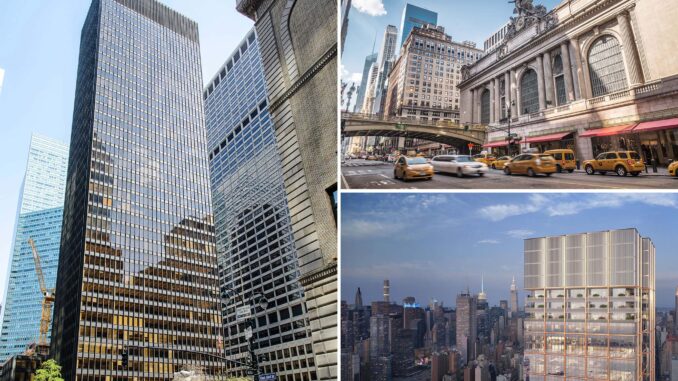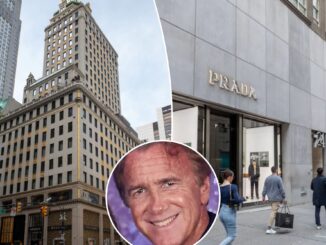
While the current 19.6% availability rate for office space is worrisome for building owners, commercial leasing brokers and their tenants are smiling again.
Tenants are out touring, seizing deals in a renter’s market. And some who had been hemming and hawing — picking away at deal points for many months or years — are finally signing on the bottom line.
“It’s happy hunting for tenants,” said Bill Montana of Savills, which exclusively represents tenants. “You are seeing landlords competing more aggressively for tenants,” added Adam Henick of Current Real Estate Advisors.
That competition has led to the creation of exciting spaces — especially in the area surrounding Grand Central Terminal — that are magnets for a return to work so “not mandated,” according to Jeffrey Peck, also of Savills.
For instance, 335 Madison, aka 22 Vanderbilt Ave., has an interior public atrium filled with restaurants and seating. The Seagram Building at 375 Park now has a basement dubbed the Playground, with a basketball court and rock climbing, as well as acting as a high-tech experience center for company activities.
Ben Friedland of CBRE says that those perks allowed him to quickly sublease a spot at the landmarked tower for his client hedge fund before it hit the market.
“Demand for quality, built space near Grand Central is in almost every conversation,” added Friedland, noting the addition of Long Island Railroad trains. “The best way to get people back to the office and the best amenity is an easy commute.”
Tech companies are also passing up traditional tech areas like Midtown South for the glass buildings in Midtown proper.
“The [tech companies] are looking at some of the best buildings in the city and want to be in Grand Central near their clients or around Penn Station near their clients,” said Steven Rotter of JLL. “They don’t need to be in the historically creative areas.”
At 340 Madison Ave., near Bryant Park, Matthew Astrachan of JLL is seeing two to three tenant tours a day. They are attracted to a large block at the top of the tower left by McDermott Will & Emery’s move to One Vanderbilt. “Some are looking for 5,000 square feet and some are 100,000- to 200,000-foot tenants,” Astrachan said. “It’s a meaningful increase in activity.”
Gabe Marans of Savills recently toured a dozen amenitized buildings with a law firm seeking 40,000 square feet. Their target amenity is an oversize shared meeting space (which saves on rent).
Views are also in high demand, but currently most available blocks in Class A towers are at the bottom, said Peter Turchin of CBRE.
Amenities are also the primary draw in the Penn District and Hudson Yards. Vornado’s new Penn 2, which turns over to tenants in December, has access to the acclaimed amenities at Vornado’s Penn 1.
Area improvements include a new public park on West 33rd Street with no cars allowed between a portion of Seventh Avenue halfway to Eighth Avenue.
“This will become the main outdoor space and will be our fun zone,” said Glen Weiss of Vornado, adding that there’s another “fun zone” under the “bustle” of Penn 2. Penn 1 rents are now averaging $90 a foot, he said.
Not surprisingly, properties with the most availability don’t have the amenities potential tenants most desire. But good spaces are being absorbed at a clip, sending the availability rate on Park Avenue in the Plaza District down from 16% in the first quarter of 2022 to 10.7% now.
“This is a huge change and because Park Avenue has the ‘prestige factor,’ the [drop in available space] tends to be in very good quality buildings,” said Turchin.
But Plaza District tenants are in a bind if they need elbow room, as the prime openings are being gobbled up at the GM Building at 767 Fifth Ave., 9 W. 57th St. and 550 Madison, where recent signings include investment advisor Clayton Dubilier & Rice, Junto Capital Management and where Simon Kim’s Gracious Hospitality Management will open a 15,000 square-foot dining concept across the three lowest levels.
In a battle for the remaining square feet, three tenants were vying for space at 9 West, now run by Stefan Soloviev, but Davidson Kempner Capital Management quickly inked a deal for nearly 100,000 square feet on three floors where it will move and expand from 75,000 square feet at 520 Madison Ave. with CBRE repping both sides.
Along with Soloviev fawning over his tenants, he’s spent $45 million on a new lobby, elevator cabs, a 27th-floor amenity space for coffee plus a 150-seat conference room, while on Jan. 1, a new fitness facility with hot and cold pools will open on a lower level.
“There will still be opportunities up to 30,000 square feet in the Plaza District,” said Rotter. “But over 100,000 square feet, they are looking at Hudson Yards.”
With building owners desperate to keep their larger tenants, brokers are also achieving strong deal packages for their clients. Real estate company Avison Young reported 67.7% of tenants over 100,000 square feet are renewing in place. Even so, Peck explained, “With all the competition, a relocation is usually less expensive than the renewal.”
That’s why an almost identical number of the more nimble, small to mid-sized companies between 25,000 and 50,000 square feet are relocating, according to real estate firm Cresa. Additionally, 60% of the top 15 law firm deals were relocations.
“They are coming to the end of a 10- to 15-year lease and have paid years of escalations so at that rent they can move to a higher-end building for the same or a lower cost,” explained Nicholas Markel, a vice president with Cresa.
But the 500,000-square-foot-and-up, goliath-sized tenants need years of lead time, especially when considering towers that can’t start financing construction without their lease. “Large occupiers are taking a disciplined and mindful approach, and many will continue to be in the market as they explore strategies to bring people together,” said Savills’ David Goldstein.
For instance, Related Companies is working on a deal to sell Wells Fargo 308,230 square feet of the former Neiman Marcus space at 20 Hudson Yards to consolidate at the project.
One such large law firm, Davis Polk & Wardwell, spent years looking at options with broker Lewis Miller of CBRE, nearly anchoring the proposed 3 Hudson Blvd. in Hudson Yards.
In the end, Scott Rechler’s RXR retained the attorneys at 450 Lexington Ave. where they will expand by 30,000 square feet to occupy 710,000 square feet after a promise of $300 million in capital improvements.
Another boon for tenants: Offices are increasingly available “turnkey,” with furniture and wiring in place. And large blocks of pre-furnished sublease space are available at Hudson Yards.
But while tenants are getting more for their money, they aren’t necessarily paying less. Rents average $74.54 per foot and trophies at $130 per foot, real estate firm Transwestern found.
Luckily, for those that just need an office, Garment District buildings still have among the lowest rents in Manhattan. Rents are down 25% since the pandemic, from the $40s and even some $50s per foot to now low- to mid-$30s per foot.
Third Avenue towers also have good value while being close enough to the core of Midtown to make them desirable. The Durst Organization’s renovation at 825 Third Ave. and Nuveen’s 730 Third Ave. are two standouts. Another example is BentallGreenOak’s 757 Third, where a London-based fintech firm — that was already on a lower full and partial floor — leased just under 7,000 square feet to get a full floor and full branding, Markel said.
“Third Avenue is back on the radar of companies that are looking for a bit of a bargain,” said Jim Wenk of Savills.
(Non-)profit seeking
The disparity in available space — much of it on lower floors — is creating an opening for non-profits to take advantage of the flight to quality.
That’s because, to comply with zoning, many office buildings have a large podium with big floor plates while the tower floors are smaller.
“A lot of times, the podium can be divided into a separate building with its own entrance, even on another street,” explained Mark Weiss of Cushman & Wakefield. “It does create a nice environment for the non-profit.”
This separation, known as a “building within a building,” also benefits the upper-floor tenants, Weiss said, as new amenities are not being overcrowded.
David Carlos, who heads the non-profit practice at JLL, said owners, architects and attorneys set up a 31-year leasehold condominium structure — known as a synthetic lease — that is then leased to the non-profit, which no longer pays property taxes, thus saving millions of dollars.
Carlos also believes properties such as the Class A office building at 300 E. 42nd St. at Second Avenue that is being sold by the lender through JLL, will see activity from the institutional non-profits, such as many of the health care and hospital tenants that line First Avenue. “Moving forward, they are going to be punching above their weight and taking a large role helping in the recovery of the office market,” Carlos said.
Real Estate – Latest NYC, US & Celebrity News



